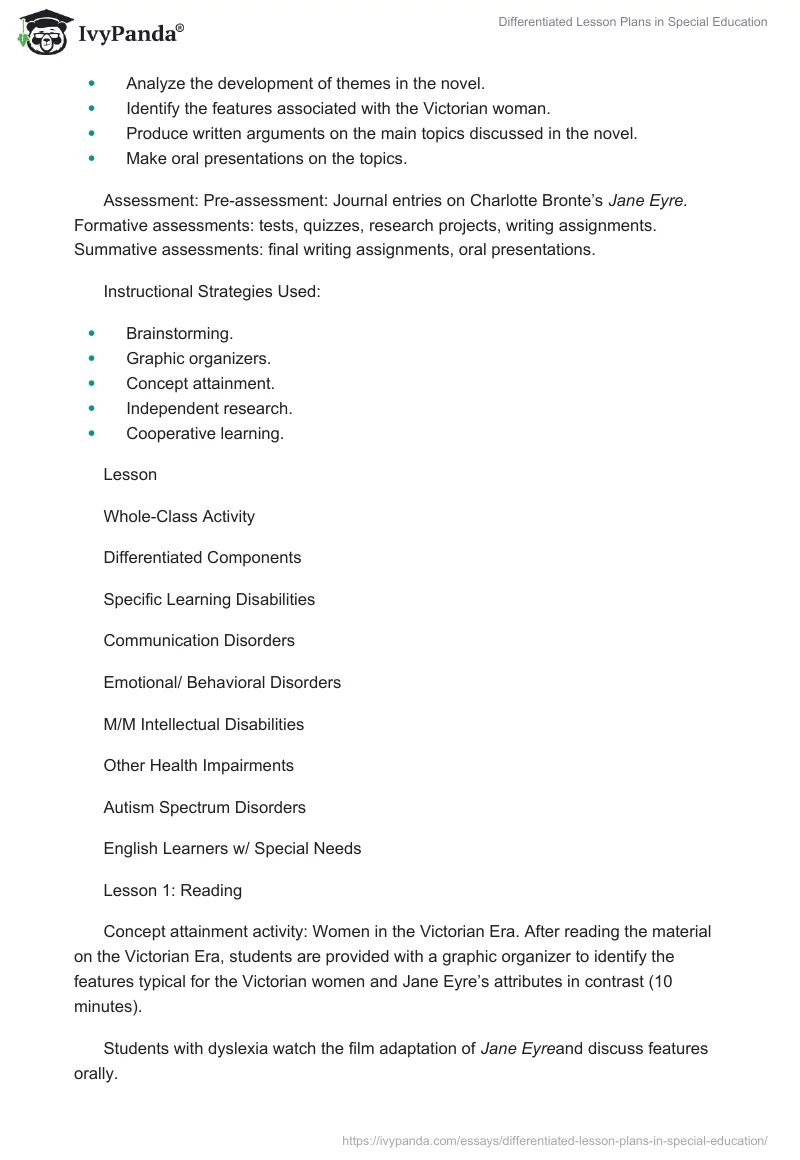Course Signature Assignment
Grade level: 11th Grade
Adopted Program in English/Language Arts: Prentice Hall Literature, Prentice Hall Writing, and Grammar.
Unit of Study: Charlotte Bronte’s Jane Eyre: A Woman’s Position during the Victorian Era.
Common Core Standards Addressed:
“1. Determine two or more themes or central ideas of a text and analyze their development over the course of the text; 2. Analyze the impact of specific word choices on meaning and tone; 3. Produce clear and coherent writing in which the development, organization, and style are appropriate to task, purpose, and audience; 4. Conduct short research projects to answer a question; 5. Plan and present an argument” (California Common Core State Standards, 2013).
Objectives or Student Outcomes: Students will know:
- The role of word choices in conveying the idea.
- The resources available to research biographical information.
- The aspects of women’s positions during the Victorian Era.
Understand:
- In order to improve the knowledge, it is necessary to research much.
Be able to do:
- Determine the main themes in work.
- Analyze the development of themes in the novel.
- Identify the features associated with the Victorian woman.
- Produce written arguments on the main topics discussed in the novel.
- Make oral presentations on the topics.
Assessment: Pre-assessment: Journal entries on Charlotte Bronte’s Jane Eyre. Formative assessments: tests, quizzes, research projects, writing assignments. Summative assessments: final writing assignments, oral presentations.
Instructional Strategies Used:
- Brainstorming.
- Graphic organizers.
- Concept attainment.
- Independent research.
- Cooperative learning.
Reflection
Having completed the assignment, I improved my skills in differentiation while addressing the needs and interests of students with different learning disabilities. I have learned how to modify the whole class activity and adapt the instructions to the needs of students with disabilities in order to achieve the set objectives and goals. Now, I can use such strategies as the concept attainment and the focus on independent research and cooperative learning; and I can use graphic organizers and visual aids not only to work with the whole class but also to work with students with disabilities. Having completed the assignment, I understand what strategies and tools to select for working with different groups of students.
The work with a general education teacher was interesting because I received the opportunity not only to modify instructions and concentrate on the differentiation strategies but also to participate in the planning of activities for the unit on Jane Eyre. The educator is only developing the unit activities, and I contributed to designing the appropriate activities for students with disabilities.
The positive outcomes of completing the assignment are the improvement of my skills in selecting the tasks, instructions, and strategies appropriate for different groups of students depending on their needs. Furthermore, the assignment demonstrated the areas for my further professional growth. Thus, I need to focus more on applying the unit and lesson objectives to the core standards while planning the activities.
Works Cited
California Common Core State Standards. 2013. Web.
Castellani, John. “Universal Accessibility and the Design of Digital Educational Materials”. Virginia Society for Technology in Education 14.3 (2002): 4-7. Print.
Chen, Deborah, June Downing, and Gloria Rodriguez-Gil. “Tactile Strategies for Children Who are Deaf-Blind”. Deaf-Blind Perspectives 8.2 (2001): 1-6. Print.
Friend, Marilyn, and Lynne Cook. Interactions: Collaboration Skills for School Professionals. New York, NY: Pearson, 2012. Print.
Nielsen, Lee Brattland. Brief Reference of Student Disabilities. USA: Corwin Press, 2008. Print.
Tomlinson, Carol, and Cindy Strickland. Differentiation in Practice: A Resource Guide for Differentiating Curriculum (9-12). Alexandria, Virginia: ASCD, 2005. Print.


